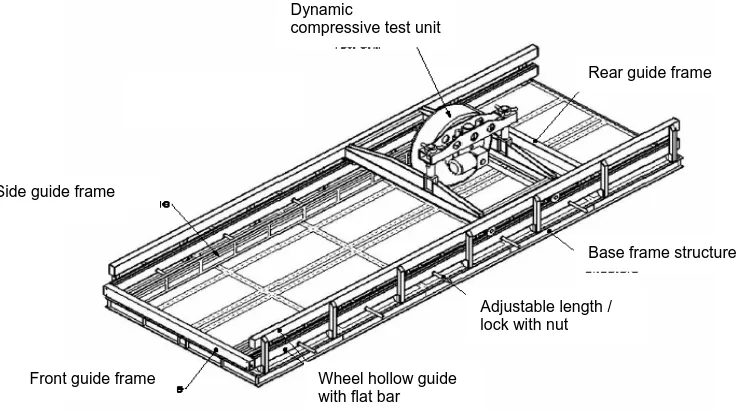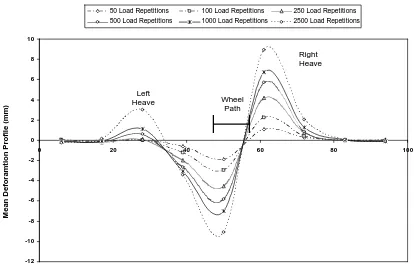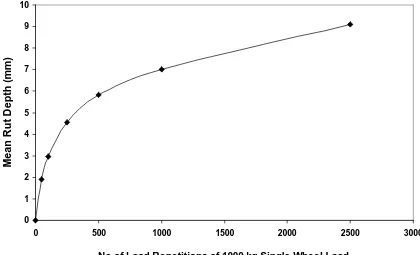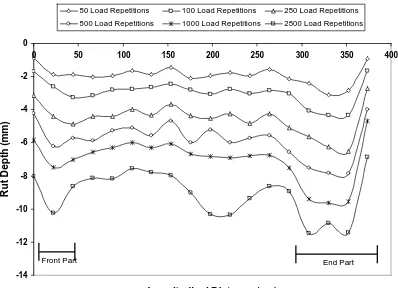Permanent Deformation of Concrete Block Pavements
Under Highway Accelerated Loading
Tung Chai Ling, Hasanan Md Nor, Ming Fai Chow
Faculty of Civil Engineering, Universiti Teknologi, Malaysia
*ABSTRACT
Experiment concrete block pavements (CBP) are essential to study and assess the structural pavement performance. Accelerated loading testing is able to determine the pavement response and performance under a controlled, accelerated, accumulation of damage in a compressed time period. A test was performed in laboratory to investigate the permanent deformation development under Highway Accelerated Loading Instrument (HALI). A CBP model constructed from the bottom with hard neoprene, bedding sand and paving blocks filled with jointing sand was prepared and tested. Up to 2500 cycles load repetitions of a 1000 kg single wheel load were applied to the pavement model. The pavement deformation development was studied through its transverse deformation profile, mean rut depth in the wheel path, longitudinal rut depth profile and joint width between paving blocks. Test results indicated that the rut depth increase with increasing number of load repetitions and also the heaves at each side of the wheel path. It has also shown that the constant deformation, accelerating and braking sections of the pavement have been observed and determined.
1 Introduction
The field evaluation of pavements subject to normal road traffic is essential to the development and verification of structural design standards. However, in these experiments, performance can be assessed only in terms of the axle loads applied to the test sections and little quantitative information can be gained regarding the relative damaging effect of different axle loads. A study of the relationship between pavement damage and axle loading is therefore necessary if the results of full-scale experiments are to be generalised and applied to other traffic conditions.
Such studies involve the use of accelerated pavement testing, where the loading can be strictly controlled. The testing involves full-scale road pavements where the traffic is restricted to repetitions of specific axle loads applied by normal road vehicles.
This paper describes a full-scale experiment conducted on a number of concrete block pavements (CPB) using the Highway Accelerated Loading Instrument (HALI). The performance of pavements is directly related to the magnitude and frequency of the applied load and the manner in which traffic loads are transferred to the pavement surface and the entire pavement structure is controlled by the tyre-pavement interaction. In the case of CBP, the distribution of stresses, strains and displacement in the pavement structure is affected by a number of factors including paver shape, size, thickness, laying pattern and the type and thickness of the bedding sand (Shackel 1994; Panda and Ghosh 2002).
2
Background to the Project
Accelerated loading devices have been widely used since the 1980s to evaluate long-term pavement performance in a relatively short period of time. A large number of accelerated pavement loading devices have been developed, many of which can be operated under controlled laboratory conditions (e.g. Shackel 1994; Steven 1999; Sharp 2004).
*
The Highway Accelerated Loading Instrument (HALI) was developed in 2006 (Figure 1). A detailed decription, including the operational characteristics, can be found in Ling, Rosli and Chow (2006). This instrument is designed to address a number of research issues associated with the structural performance of pavements under a range of testing conditions.
As this was the first experiment conducted using the HALI the opportunity was also taken to obcserve ceratin behavioural characteristics, including the extent of the heave generated along each side of the wheelpath and the length of test section where the load was constant and not affected by the acceleration and deceleration of the load at the start and end of the 4 metre long test track.
Figure 1: Highway Accelerated Loading Instrument (HALI)
3 Project
Description
The CMP test sections were constructed within the steel box structure. A steel plate was covered with a layer of hard neoprene, 3 mm thick, to simulate the subgrade. A plastic sheet was placed over the neoprene in order to avoid contamination with the bedding sand. The plastic was used as an experimental expedient only and would not normally be used in practice (Teiborlang, Mazumdar and Pandey 2005). The dry bedding sand was spread to a uniform depth of 50 mm. This value was selected based on work conducted by Shackel (1994). Rectangular blocks, 60 mm thick, were laid manually by hand over the bedding sand. Where necessary, blocks were sawed to fix the box at the edges of the test frame. The nominal joint width was 5 mm. After jointing sand was placed on the surface to fill the gaps, the pavement was compacted using a plate vibrator. Another layer of jointing sand was then applied to ensure that the joints were fully filled. The pavement was then re-compacted using a plate vibrator.
The following test conditions were used in the experiment:
speed 0.18 m/s
cycle time 22 seconds – length of test pavement 4 m axle load 1 tonne (9.81 kN)
Number of cycles 50, 100, 250, 500, 1000 and 2500
Permanent deformation ws measured with reference to a fixed datum using dial gauges after 50 repetitions to the maximum number repetitions of 2500 cycles of the single wheel load. The dial gauges were positioned at the marked points to ensure that measurement were taken at the same
Rear guide frame
Base frame structure
Adjustable length / lock with nut
Front guide frame Wheel hollow guide with flat bar Side guide frame
Dynamic
The test bed was also positioned at a distance of 220 mm between each cross-section along the length (Y-axis). This enabled 162 measurements to be recorded at known plan positions on the surface (on a 1.0 x 4.0 m grid test bed). Nine dial gauges were also positioned 110 mm apart on the rigid beam of the HALI. Once the data was recorded, the instrument was moved to the next cross-section and the process repeated. When all the cross cross-sections had been measured, the survey data was processed using the SURFER program which uses a Kriging routine to generate a representative three-dimensional surface from the survey data (Mills, Newton and Pierson2001). Joint widths at sections beside the wheelpath were also measured in line with the recommeddations of Knapton (2000).
4
Results And Analysis
4.1 Transverse Deformation Profiles
Figure 2 shows the results of transverse deformation profiles of the wheel track loaded with the standard wide single tyre. The results are the mean of 18 adjacent transverse profiles. As expected, most of the rutting occurred under the wheel path. It is clearly seen that not only the rut depth increase with the increasing number of load repetitions, but also the heaves at the both sides of the wheel track. The total mean rut depth in the wheel path after 2500 load repetitions of 1000 kg load magnitude is approximately 9.09 mm. An interesting observation obtained is that the right side heave level of the wheel path is higher than the left side heave level. There is a difference of 5.92 mm between the right heave level and the left heave level after 2500 cycles of load repetitions.
The differences in the magnitude of the heave along both sides of the test bed is believed to be due to the fact that the load is applied to the tyre by the hydraulic jack, which is located at the right-hand side of the tyre. As a result, the load distribution of the tyre concentrates more on the right-hand side of the wheelpath, resulting in a higher magnitude of heave along that side.
-12 -10 -8 -6 -4 -2 0 2 4 6 8 10
0 20 40 60 80 100
Transverse Distance (cm)
M e a n D e fo ra m tio n P ro fil e ( m m )
50 Load Repetitions 100 Load Repetitions 250 Load Repetitions 500 Load Repetitions 1000 Load Repetitions 2500 Load Repetitions
Figure 2: Transverse deformation profiles for different numbers of load repetitions
4.2 Mean Deformation in Wheelpath
Figure 3 compares the mean rut depth in the wheelpath with the number of load repetitions. It can be seen that the increase in deformation is non-linear and that the rate of increase in deformation decreases as the number of load repetitions increase.
During loading, additional compaction of the bedding sand layer occurs but, after a certain number of repetitions, the compaction of the underlying layers reaches its maximum and no energy is lost during the additional loading. As a result, the deflection induced under load, and recovery, is the same. This demonstrates that the block pavements progressively stiffened as the number of load repetitions increased.
0 1 2 3 4 5 6 7 8 9 10
0 500 1000 1500 2000 2500 3000
No of Load Repetitions of 1000 kg Single Wheel Load
M
e
a
n
Ru
t De
p
th
(
m
m
)
Figure 3: Comparision of mean deformation and number of load repetitions
4.3 Longitudinal
Deformation
Figure 4 shows a typical relationship between longitudinal deformation along the centre of the wheelpath and the number of load repetitions. It is seen that the deformation in the front and end sections of the pavement was higher than the middle section. For the front section, the deformation increased significantly until the 3th cross section to a distance of 440 mm. After that, the deformation remained constant along the middle section of the pavement track. The length of the test track where the deformation remained constant was approximately 2.42 m; this commenced from the 3th cross-section to the 14th cross-section.
-14 -12 -10 -8 -6 -4 -2 0
0 50 100 150 200 250 300 350 400
Longitudinal Distance (cm)
Ru
t De
p
th
(
m
m
)
50 Load Repetitions 100 Load Repetitions 250 Load Repetitions
500 Load Repetitions 1000 Load Repetitions 2500 Load Repetitions
Figure 3: Typical relationship between longitudinal deformation and load repetitions
4.4 Three-Dimensional View of Deformed Pavement
A three-dimensional view of the deformed pavement was obtained using the SURFER computer program. These three-dimensional views were plotted in order to investigate the development of deformation in the pavement after loading.
Figure 5 shows typical three-dimensional views of the pavement for 50 and 2500 load repetitions respectively. From the Figure 5, it can be clearly observed that shoving occured at the right-hand side of the wheelpath. This shoving commenced at a distance of about 2 metres from the origin of measurement. Compared to the deformation after 50 load repetitions, the deformation after 2500 load repetitions was more critical. At that stage, the deformation became excessive and substantial rotations and heaving of the individual blocks occurred.
50 load repetitions 2500 load repetitions
Figure 5: Three-dimensional view of deformed pavement after loading
4.5 Analysis of Joint Width
Figure 6 shows the locations (A, B, C and D) where joint width was measured, while Table 1 shows the mean joint width at both sides of the wheelpath for various load repetitions. It can be clearly seen that the mean joint width at Locations A and D increased with the number of load repetitions. However, the mean joint width in Locations B and C decreased significantly with the number of load repetitions. The joint width in these two sections finally decreased to 0 mm when two adjacent blocks stuck together.
A B C D
Paving block
Bedding sand
Plastic sheet Hard neoprene
Figure 6: Joint width at locations A, B, C and D along the transverse deformation profile
Table 4.1: Mean joint width for various load repetitions
Mean joint width (mm)
No. of load cycles Location A Location B Location C Location D
0 5.00 5.00 5.00 5.00
50 5.72 4.44 3.38 6.60 100 5.99 4.07 0.78 8.16 250 6.47 3.41 0.07 9.37 500 6.55 2.53 0.12 9.60
1000 7.04 1.29 0.00 10.94
2500 7.52 0.00 0.00 12.54
5 CONCLUSIONS
This paper has described a full-scale experiment conducted on a number of concrete block pavements (CPB) using the Highway Accelerated Loading Instrument (HALI). The main finidings of the study are as follows:
The block pavement exhibited progressive stiffening with the increase in the number of load repetitions.
The magnitude of the heave at the right hand side of the wheelpath was higher that the heave on the left hand side of the wheelpath; however, this was most probably related to the mechanism by which the load was applied.
As this was the first experiment conducted using the HALI the opportunity was also taken to observe certain behavioural characteristics, including the extent of the heave generated along each side of the wheelpath and the length of test section where the load was constant and not affected by the acceleration and deceleration of the load at the start and end of the 4 metre long test track. It was found that:
the length of the 4 metre length of test pavement where the deformation was constant was about 2.42 m along the middle section of the pavement
Acknowledgement
This study was performed as part of a research grant provided for a project titled Development New Technologies for Interlocking Concrete Block Pavement (ICBP). The authors express their sincere thanks to the Ministry of Science, Technology and Innovation (MOSTI), Malaysia, under the IRPA research grant no. 03-02-06-0129-EA0001.
References
Knapton, J 2000, The performance of pavers for mechanical installation. Department of Civil Engineering, University of Newcastle upon Tyne.
Ling, TC, Hasanan, MN, Rosli, H and Chow, MF 2006, Highway Accelerated Loading Instrument (HALI) for concrete block pavement. SPEKA. Universiti Teknologi Malayisa, Skudai, Malaysia, 19th–20th December
Mills, JP, Newton, I and Pierson, GC 2001, Pavement deformation monitoring in a rolling load facility.
Photogrammetric Record, 17(97), pp. 7-24.
Panda, BC and Ghosh, AK 2002, Structural behaviour of concrete block paving. II: concrete blocks. Journal of Transportation Engineering 128(2), pp. 130-135.
Shackel, B 1994, Introduction to concrete block paving. Parkroyal, Kuala Lumpur, 14-15th November.
Steven, BD, de Pont, J, Pidwerbesky, BD and Arnold, G 1999, Accelerated dynamic loading of flexible pavements at CAPTIF. Proc. 1st International Conference on Accelerated Pavement Testing, Paper GS2-3.
Sharp, KG 2004, Full scale accelerated pavement testing: a southern hemisphere and Asian
perspective. Proc. 2nd International Conference on Accelerated Pavement Testing, Minneapolis, Minnesota, USA.
Panda, BC and Ghosh, AK 2002, Structural behaviour of concrete block paving. II: concrete blocks. Journal of Transportation Engineering 128(2), pp. 130-135.




